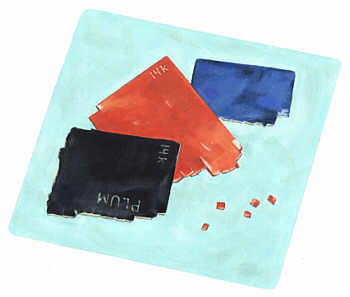Color Coding Solder Chips
Let's face it, not every snippet of solder winds up in your work. Some pieces fly away during clipping, while others jump on the floor or fall into your catch pan, never to be found again. You might even accidentally spill one tray of solder snippets into another, mixing two different grades and creating a useless chaos. (After all, unless you are 100 percent sure which grade of solder snippet you have, you cannot use it.) To make your life easy...
1 Minute Read
This article tells you about color coding solder chips, why and how.
Let's face it, not every snippet of solder winds up in your work. Some pieces fly away during clipping, while others jump on the floor or fall into your catch pan, never to be found again. You might even accidentally spill one tray of solder snippets into another, mixing two different grades and creating a useless chaos. (After all, unless you are 100 percent sure which grade of solder snippet you have, you cannot use it.)
To make your life easy, color code all your solders when you first get them. Use fat permanent marking pens of various colors to indicate the melting temperature. For instance, use red ink to cover both sides of your hard solder sheet (the hottest color for the hottest flow temperature). Use black ink for medium, and use blue or green ink for easy solder (the lowest flow temperature). Cover both sides completely.
When you need solder, cut a piece off the appropriate sheet (hard, medium, or easy). It is now simple to find and identify solder snippets, no matter where they fall. And the ink burns off cleanly a long time before the solder begins to flow.
The award-winning Journal is published monthly by MJSA, the trade association for professional jewelry makers, designers, and related suppliers. It offers design ideas, fabrication and production techniques, bench tips, business and marketing insights, and trend and technology updates—the information crucial for business success. “More than other publications, MJSA Journal is oriented toward people like me: those trying to earn a living by designing and making jewelry,” says Jim Binnion of James Binnion Metal Arts.
Click here to read our latest articles
Click here to get a FREE four-month trial subscription.
You assume all responsibility and risk for the use of the safety resources available on or through this web page. The International Gem Society LLC does not assume any liability for the materials, information and opinions provided on, or available through, this web page. No advice or information provided by this website shall create any warranty. Reliance on such advice, information or the content of this web page is solely at your own risk, including without limitation any safety guidelines, resources or precautions, or any other information related to safety that may be available on or through this web page. The International Gem Society LLC disclaims any liability for injury, death or damages resulting from the use thereof.
The All-In-One Jewelry Making Solution At Your Fingertips
When you join the Ganoksin community, you get the tools you need to take your work to the next level.
Trusted Jewelry Making Information & Techniques
Sign up to receive the latest articles, techniques, and inspirations with our free newsletter.
